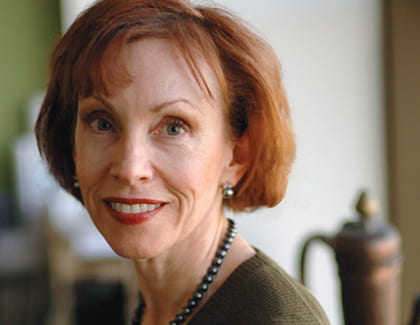From many, one
Campus Architect Rebekah Gladson blends a variety of styles into a cohesive whole

Like a proud parent, campus architect and Associate Vice Chancellor Rebekah Gladson hates to say which UC Irvine building is her favorite. “There are various things about each building I like,” she says diplomatically. Still, she admits, there is one spot that she favors, just on the edge of Ring Mall. Walking past the new Biological Sciences III building toward Natural Sciences I, pedestrians encounter a combination of elements, including the hard concrete edges of a “stramp” (a combination of stairs and ramp) that zigzags to the left, the warm texture of the surrounding brick and stone surfaces, and the cool curved glass of the buildings’ entrances.
It’s telling that Gladson doesn’t point to a single structure, but to a defined space created by multiple architectural features. Her vision for UCI isn’t simply to add more high-profile buildings, but to give the campus a cohesive sense of place – the kind of memorable setting that defines a great city.
“If you think about places in the world renowned for their architecture, they all have a strong contextual fabric,” Gladson says. “When you think of Florence, you don’t just think of the Duomo – the magnificent cathedral. You think of all the red tile roofs, the terra cotta buildings, the intimacy of the streets. There’s a wonderful feeling of place. That kind of environment is not created by just one building.”
Blending styles
Creating a feeling of place at UCI poses particular challenges. When Gladson was hired 20 years ago, she inherited a campus with two distinct styles: brutalism, named for the exploratory use of “brute” materials like concrete, and postmodernism, which emphasizes diversity, innovation and a refusal to be confined to past architectural styles. Brutalist buildings, including the Gateway Study Center and Langson Library, both by renowned architect William Pereira, “marched around the ring” of the campus in the 1960s and ’70s. They were followed in the ’80s by “a sprinkling of postmodern buildings” designed by various well-known architects commissioned by campus architect David Neuman.
Gladson began reconciling the two movements, and setting a course for a unifying architectural style, by adopting a contextual approach to design. Instead of the individual, look-at-me philosophy of postmodernists, contextualists believe a new building should harmonize with its surroundings, complementing existing structures. To foster contextualism on campus, Gladson hired architects whose buildings, while unique, share the same classical “architectural vocabulary.” David Martin, for instance, designed three new buildings for the humanities and arts that, in his words, “define outdoor space and create order and identity.” With its protruding arms and sweeping curved entrance, Martin’s Humanities Instructional Building naturally ushers passersby on Ring Mall into an inviting space reminiscent of a plaza in an old European city. Think Venice’s famed Piazza San Marco – without the pigeons.
“Everything’s done on a pedestrian scale that allows people to interact with their surroundings,” Gladson points out.
Proper scale
To bring a sense of place to UCI, Gladson finds inspiration abroad – in cities best experienced on foot. Among her favorite haunts: the narrow medieval alleys of Siena, the romantic bridges of Florence and the elegant boulevards of Prague.
“European cities have more in common with a university campus than cities in the U.S. because they’re much more intimate environments,” Gladson contends. “In American cities, especially in California, everything is done on the scale of a car. You experience buildings at 60 miles an hour.”
For Gladson, overseeing the campus’s development provides a unique opportunity to create an environment that students and faculty will find memorable – much like a trip to Siena or Florence.
“We’re working to make UCI one of the truly special places,” she says.
Design, build, dream
It’s a tough job – realizing a grand architectural vision for UCI within the confines of a limited budget. But as leader of Design and Construction Services, it’s Rebekah Gladson’s responsibility to do just that. She oversees all major capital projects on campus and at UCI Medical Center, with $1 billion in construction currently in design or progress and the cost of steel, concrete, drywall and other basic building materials on the rise due to international demand.
To maximize the university’s resources, Gladson’s become a leading proponent of the design build approach, which puts architecture and construction services under a single contract. It’s a return to the days of the master builder, when a single source was responsible for designing the project, procuring materials, overseeing craftsmen and controlling every aspect of the project. Gladson, chair-elect of the National Board of the Design-Build Institute of America, says the process streamlines project delivery and controls costs, which are key to the success of UCI’s building plan.
“Rebekah has achieved physical results at UCI in a way that is creative, highly efficient and cost-effective,” remarks UC Regent Judith Hopkinson, chair of grounds and buildings. “She uses a design-build approach that requires a high degree of management expertise married to a design vision – and she has both. She has been instrumental in creating a sense of place and an architectural quality at UCI of which we can all be proud.”
